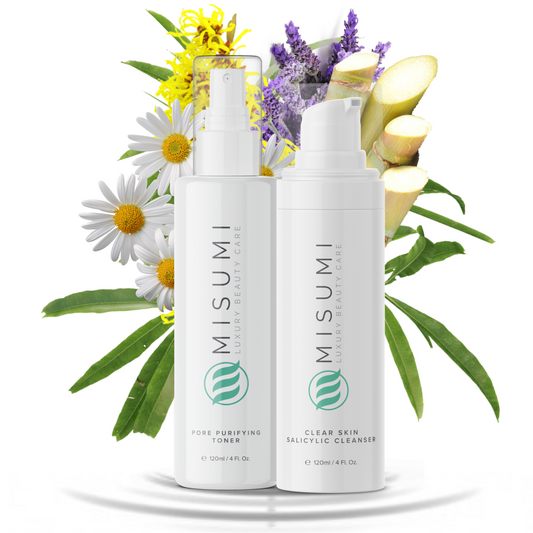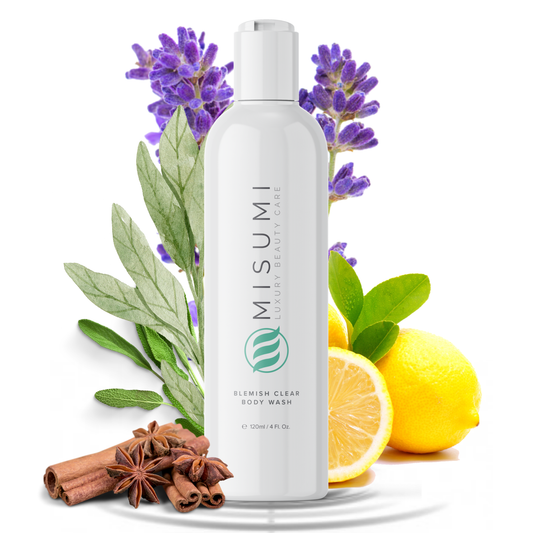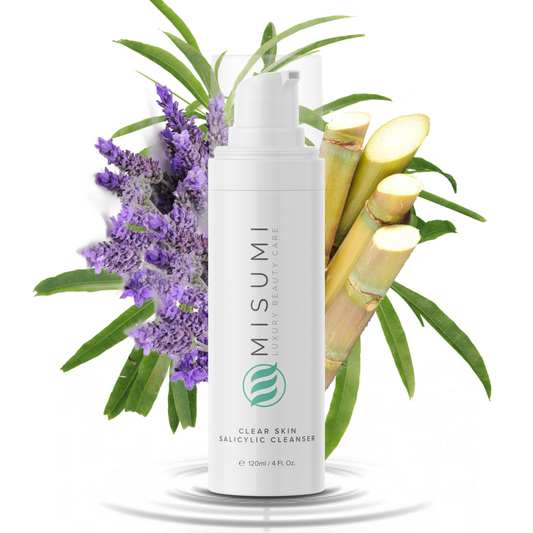A healthy diet is crucial for a long and productive life. Wherever you go, there seems to be a debate about diet, and so it's no surprise that we as a society are so food-oriented.
But what's the deal with acne and diet? Most of us have gone through a period when we break out like crazy and don’t know what’s causing it. Turns out, looking after your complexion is more than just investing in a good skincare routine. Food might be to blame.
Studies regarding the role of diet in acne formation are still recent, so it’s not easy to make a universal list of food you should avoid if you have acne-prone skin. And different food affects people differently.
That being said, there is enough evidence to conclude that certain foods should be kept to a minimum to avoid exasperating our breakouts and promote good skin health. So, which foods can contribute to developing acne? Let’s find out.
Dairy and Milk

Speaking of research, did you know that there are some studies done in regard to how milk affects acne vulgaris? The participants of dairy-related studies are almost always teenagers, and the results won’t be shocking if you’ve ever researched this topic. Those who consumed high amounts of dairy products seemed to have the worst teenage acne out of all the participants. This makes us wonder: what exactly is in milk that makes our skin bad?
One answer might be due to the high amounts of hormones found in dairy and milk. Because milk is created for the sole purpose of feeding baby calves, it’s filled with all kinds of hormones.
Milk is full of androgen hormones, proven to worsen acne lesions and trigger breakouts. High amounts of testosterone, in particular, almost always result in the formation of acne. Through testosterone, dihydrotestosterone is created, or DHT for short. This causes our skin to produce more oil than usual, and we all know by now that an overproduction of sebum is one of the most common causes of acne there is.
Not to mention, most cows are given additional hormones by farmers. This stimulates milk production, increasing the amount of produce and profit.

Milk consumption is linked to high IGF-1 levels - a hormone that's often referred to as the “growth” factor and is very similar to insulin. It’s shown to worsen acne and cause us to break out even more. Thankfully, the number of studies conducted has been enough to warn us about the effects of this growth factor on our skin health.
What About Skim Milk?

Skimmed milk plays just as big of a part in causing acne breakouts as regular milk - if not more. Whey protein, found in skim milk, is known to cause inflammation and mess with our skin, leading to acne.
When it comes to hormones, skimmed milk is not devoid of hormones that trigger acne. On top of that, skim milk often contains added sugar, which causes inflammation in the body, and, in turn, acne. Processed sugar has a high glycemic index and is generally not recommended if you have acne or similar skin conditions.
But should you limit your favorite dairy-based products, such as cheese and ice cream consumption?
What to Use Instead
If you’re a milk lover, what can you do to ensure you aren’t experiencing any dairy-related breakouts? Most of us can’t eliminate dairy cold turkey, so it’s best to begin with small steps, such as decreasing the amount of skim milk you consume.
Luckily, in this day and age, there are alternatives to make this switch easier and achieve a glowing complexion. Many plant milks are on the market, and their popularity is growing by the day. Almond, oat, hazelnut, soy, and cashew milk make for amazing alternatives for cooking and including in drinks such as smoothies and coffee.
Plant-based dairy products are also available and can be found in almost any supermarket. Are you a fan of ice cream? Don’t despair; you won’t have to give it up. Dairy-free ice cream tastes delicious!

So, if you suspect milk is causing you to break out, don’t worry! Make the switch, and you won’t notice a difference in taste or texture, but you just might reduce acne breakouts. Trust us - your complexion will thank you later.
Refined Sugar and Carbohydrates

You'll find these in a high-glycemic load diet. Refined carbs spike up blood sugar levels, which then causes insulin levels to rise. High insulin levels are linked to acne because, like milk, they increase the IGF-1 growth factor. This worsens existing acne, particularly because it causes an increase in oil production, which we know is one of the biggest threats to our skin.
On the other hand, food that has a low glycemic index is shown to improve all sorts of skin conditions, including acne. This is one of the reasons why, when you visit a dermatologist, they ask you questions about your diet. These inquiries are typically followed by suggestions of which food you should include in your diet, and, as you can already guess by now, food with a low glycemic index is on the list.

Let’s determine what exactly falls under this category of refined sugar and carbohydrates so you know which foods to avoid in the future. This includes white pasta and bread (or anything made from white flour, for that matter), desserts high in sugar, sodas, juices, sweeteners, white rice, and pastries.
If your food consists predominantly of vegetables, fruits, and whole grains, will eating one pastry once in a while hurt your skin? The answer is no. So, do your best to eat healthily but have a relaxed approach at the same time.
Chocolate
Chocolate is one of the biggest suspects when it comes to triggering acne. For decades, dermatologists have suspected that this delicious treat is to blame for some breakouts.

There are several studies that suggest this frightening claim to be true. But what is it in chocolate that makes people break out? Unfortunately, we don’t have a final answer just yet.
Some people claim that cocoa itself is a substance that forms acne, while others believe it's the milk in chocolate that leads to these results. There is a third option – the sugar in chocolate might be to blame for reasons we’ve discussed previously.
Should you give up chocolate altogether if you suffer from mild, moderate, or even severe acne? Fortunately, you don’t have to take such drastic steps. Firstly, you need to make sure the acne you have is really caused by chocolate and not something else. Closely examine your habits and maybe keep a chocolate diary. If you notice a pattern with chocolate and acne, lower your chocolate consumption and switch to dark chocolate, to be on the safe side.
Fast Food
There is no need to remind you how bad fast, highly-processed food is for our bodies; you've probably heard enough of it. Yet the typical Western diet is full of it. Hot dogs, burgers, fries, sodas, and cheesecakes are not your skin’s friend.
But why?
We assume the skin breaks out due to the change in hormonal levels that we undergo when our diet consists primarily of fast food. Another way fast food can hurt the skin is by increasing sebum production. Fast food is high in fat, which is not ideal if you want clear and healthy skin. It’s also high in sugar, which has negative effects we've already shared with you.

There isn’t enough research to conclude why fast food has a bad impact on the skin. Of course, some people are lucky enough to eat all the fries in the world and never experience a breakout. Your response will depend on many factors - not just the food itself - so try to leave any comparisons to other people out of the picture.
How Long Until You See Results
The answer is simple. All the positive changes you anticipate will take time to show up on your skin. It won’t take as long as some acne medication or other methods do, but it will take a couple of weeks for your body to adjust to this new lifestyle.
You'll start to see improvements in your skin two to three weeks after you’ve switched up your diet. Once your body has detoxed from these harmful substances, your complexion will improve, and you will be more motivated than ever to continue with the changes. Every positive change you make takes a while to prove fruitful, but it’s worth it in the end.
We also suggest pairing any food changes with an amazing skincare routine. Misumi's toner, cleanser, and moisturizer are specifically designed to combat acne.
What to Eat Instead

Don’t worry; you won’t be left hanging. It’s important to balance all this information about which foods worsen acne with actual advice on what to eat instead. Here is a list of foods that are proven to have a positive effect on your complexion.
Unlike omega-6 fatty acids, omega-3 fatty acids are amazing for hydrating your skin inside out and fighting inflammation. The best sources of omega-3 fatty acids are flaxseed, chia seeds, soybeans, and walnuts. Avoid vegetable oils as often as possible so that your omega-3 to omega-6 ratio stays on point.
Antioxidants are a part of every healthy diet. Not only do they help with the skin, but they also protect against many diseases. Antioxidants can be found in dark leafy greens, fruit, berries, red wine, and dark chocolate. Fruits and vegetables are rich in antioxidants and contain a high amount of vitamins such as A, E, and D. These are extremely important for improving your skin conditions.
If you think you’re not getting enough of these in your diet already, you could supplement with a multivitamin. Making these switches and cutting out fatty foods will also improve your blood sugar.

Turmeric is an incredible tool for healing acne and fighting inflammation. Turmeric has been used in medicine for centuries and for a good reason. Curcumin, the ingredient found in turmeric, also has an antibacterial effect that helps fight off acne-causing bacteria. The good news is that turmeric is very easy to incorporate into your diet. If you don’t like the taste of it, add a teaspoon of turmeric to your smoothie, and you won’t even know it's there!
Consider Starting a Food Diary
While you’re on this journey to achieve clear skin, be perceptive of any change that occurs in your body - both positive and negative. Keeping a food diary makes it easy to identify which food positively affects your skin and which worsens acne. Keeping a food log might be time-consuming, but it will ultimately pay off.
If you have doubts and concerns, consider visiting a dermatologist for specific guidance and a food plan.
Final Thoughts
Every person will react to food differently. Some people never get food-related breakouts, while others strongly react to foods like dairy and chocolate. Whether you have little or no acne or severe acne vulgaris, the key to determining which foods don’t agree with your skin is to be perceptive of any changes that might occur and react accordingly.
If you suspect something is causing you to break out, then eliminate it from your diet, and you will start to see results in no time.
If you have untreated acne vulgaris, don't just cut high glycemic foods from your diet - make sure to see a dermatologist.
References
Dairy Intake and Acne Vulgaris








